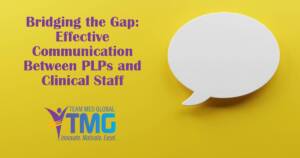 Provider Lifecycle Professionals (PLPs) work behind the scenes to ensure that healthcare operations run smoothly, tackling everything from licensing and credentialing to enrollment and quality. But their impact doesn’t stop at administrative efficiency. PLPs are deeply connected to the clinical environment, and effective communication with clinical staff is essential for maintaining trust, safety, and performance across the organization.
Provider Lifecycle Professionals (PLPs) work behind the scenes to ensure that healthcare operations run smoothly, tackling everything from licensing and credentialing to enrollment and quality. But their impact doesn’t stop at administrative efficiency. PLPs are deeply connected to the clinical environment, and effective communication with clinical staff is essential for maintaining trust, safety, and performance across the organization.
When communication breaks down, so does coordination. That’s why strong, clear, and collaborative communication between PLPs and clinical staff isn’t just a nice-to-have—it’s a must-have.
Understand Each Other’s World
One of the first steps to effective communication is mutual understanding. PLPs and clinical staff operate in different spheres with different pressures. A surgeon may be focused on OR scheduling, patient outcomes, and case volume. A PLP may be trying to finalize credentialing documents to meet a committee deadline. The disconnect often isn’t due to unwillingness—it’s due to competing priorities.
Building communication bridges means learning to speak one another’s language. PLPs who take the time to understand what matters most to clinical staff and vice versa are better equipped to build trust and reduce friction.
Be Clear, Concise, and Contextual
Clinical staff are bombarded with emails, notifications, and time-sensitive updates. That means your messages as a PLP must be clear, concise, and contextual. Whether you’re requesting a missing document, notifying them of reappointment deadlines, or clarifying a policy, make sure you:
- State what’s needed and when
- Explain why it matters in their context (e.g., delays could affect their ability to practice)
- Avoid jargon that may not be familiar outside of credentialing or enrollment
Always assume your message will be read quickly, so write accordingly.
Use the Right Channels
Not every update needs to be a formal email. In fact, overusing email can lead to your messages being overlooked. If your organization uses secure messaging apps, team huddles, or in-person rounding, consider which channel makes the most sense based on urgency and tone.
When in doubt, use layered communication: send an email with details and follow up in person or via phone to make sure nothing gets missed. PLPs who are visible, accessible, and proactive build stronger relationships and resolve issues faster.
Lead with Professionalism, Not Frustration
It’s easy to feel discouraged when clinical staff delay document submissions or miss deadlines. But effective communication means managing your own tone and expectations. Lead with professionalism. Assume positive intent. Most clinical staff are trying to juggle a demanding load and appreciate a reminder when it’s respectful, timely, and empathetic.
You’re Not Just Communicating—You’re Collaborating
Ultimately, communication between PLPs and clinical staff isn’t transactional—it’s collaborative. You’re both working toward the same goal: high-quality care delivered by qualified, well-supported providers. When communication becomes a partnership rather than a push, everyone wins.
At TMG, we believe that PLPs are key connectors in the healthcare system. By honing communication strategies, PLPs can elevate their influence, improve compliance, and strengthen the provider experience—one conversation at a time.

